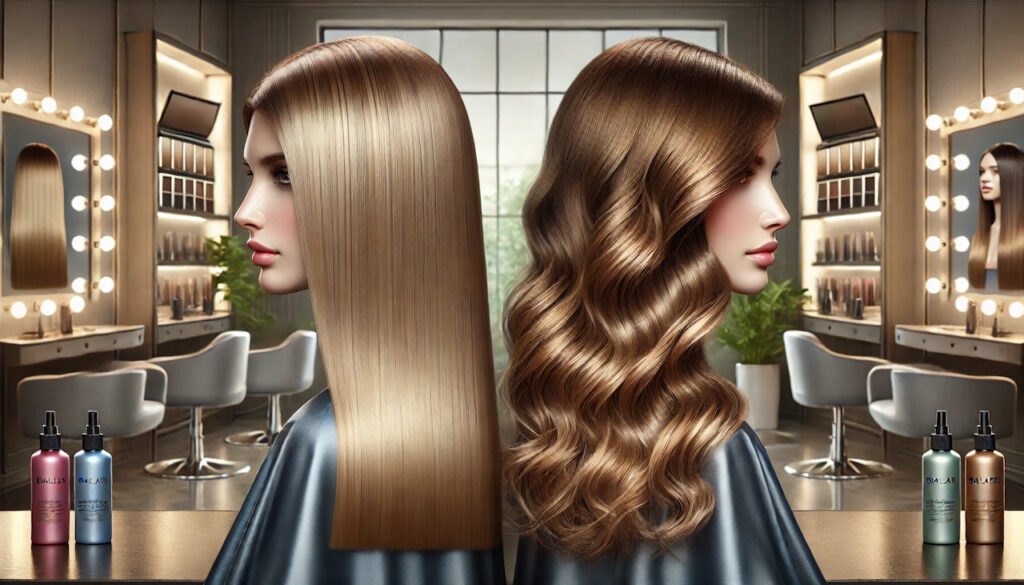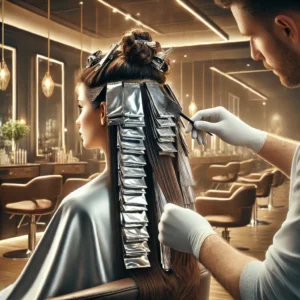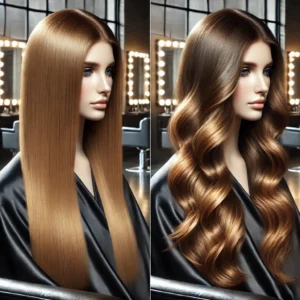Comprehensive Guide to Foiling vs. Balayage Hair Highlighting Techniques
When considering transformative hair highlighting techniques, balayage and Foiling emerge as two prominent methods that can significantly alter your appearance. Each technique is meticulously crafted to enhance your hair with stunning highlights, yet they exhibit notable differences in their application methods and the visual effects they yield. Foiling is a traditional technique where select sections of hair are wrapped in foil after being treated with a lightener or dye. This process ensures remarkable precision in highlight placement, making it an ideal choice for those who desire well-defined results.
This careful approach results in a sleek and defined hairstyle, perfect for individuals looking for a striking transformation or a bold contrast to their base color. In contrast, balayage introduces an artistic touch, where the stylist employs a freehand painting method to apply color directly onto the hair, focusing on the mid-lengths and ends while preserving darker roots for a more effortless, sun-kissed effect. The soft transitions typical of balayage often require less frequent upkeep, making it a favored choice for those who enjoy a relaxed, lived-in look that evolves beautifully over time.
Understanding these key differences is essential to making an informed decision that aligns with your individual style and daily lifestyle preferences.

Essential Factors to Consider When Choosing Between Foiling and Balayage
- Foiling involves wrapping sections of hair in foil to achieve precise, uniform highlights, whereas balayage uses a freehand technique that creates a more organic, sun-kissed appearance.
- Foiling offers benefits such as the ability to achieve consistent, controlled results while effectively lightening hair shades; however, it may lead to noticeable regrowth and can create a more structured, less natural look.
- In contrast, balayage is celebrated for its low-maintenance quality and ability to seamlessly blend with your natural hair color. However, possible downsides may include uneven color distribution and the need for regular touch-ups.
- Individuals with dark, thick, or coarse hair may find foiling particularly beneficial, especially if they desire a dramatic, high-contrast look.
- On the other hand, balayage is often well-suited for fine or thin hair, offering a subtle, blended effect that minimizes the visibility of regrowth.
- To maintain foiled highlights, it’s crucial to use color-safe products, limit excessive heat styling, and schedule regular touch-up appointments with your stylist.
- For balayage, use color-safe products, reduce sun exposure, and maintain regular toning sessions with your stylist to preserve your vibrant look.
- When deciding between foiling and balayage, consider your desired aesthetic, hair type, maintenance preferences, and budget to make the most informed choice based on your understanding of the advantages and disadvantages of foiling.
 Explore the Advantages of Foiling: Discover Why It’s a Preferred Choice
Explore the Advantages of Foiling: Discover Why It’s a Preferred Choice
Foiling presents several compelling advantages that contribute to its status as a popular choice for those seeking vibrant and eye-catching highlights. The most notable benefit of foiling lies in its precision; each section of hair is meticulously wrapped in foil, which allows for accurate color application exactly where it’s desired. This high level of precision is particularly beneficial for individuals with darker hair looking to achieve significant lift or contrast without compromising the overall look.
Furthermore, the uniform appearance that foiling provides makes it an excellent option for anyone who prefers a polished and sophisticated finish to their hair. However, it is vital to consider the potential downsides of this technique. The foiling process can be quite time-consuming, often taking several hours, particularly for those with longer or thicker hair. Additionally, the foils can trap heat, intensifying the lightening process, which may lead to hair damage if not done with care. If your lifestyle is busy or you prefer a more effortless hair care routine, you might discover that foiling entails more maintenance than you are willing to manage.
Weighing the Benefits and Challenges of Balayage
Balayage comes with numerous advantages that attract individuals seeking a more natural, effortless hairstyle. One of the most prominent benefits of this technique is its low-maintenance characteristic. Since balayage highlights are designed to mimic natural sun exposure, they grow out gracefully, avoiding harsh lines or noticeable regrowth. This quality translates to fewer salon visits for touch-ups, making balayage an exceptional option for those with a busy lifestyle.
However, it is important to acknowledge that balayage may not deliver the same level of contrast as foiling. If you are searching for bold, dramatic highlights, you may find that balayage does not meet the intensity you desire. Additionally, the success of balayage largely hinges on the skill and artistry of the stylist. Therefore, selecting an experienced professional who can understand and execute your vision is crucial to achieving the results you want.
Identifying Hair Types That Benefit Most from Foiling Techniques
Foiling is particularly advantageous for specific hair types and textures. For individuals with thick or coarse hair, foiling can create vibrant highlights that stand out distinctly against the natural base color. The precision of foiling allows for targeted color placement, enhancing the hair’s natural texture and dimension. Additionally, individuals with naturally dark hair seeking significant lift or contrast often find foiling to be the most effective approach.
Even those with fine or thin hair can benefit from foiling, as this technique can create an illusion of volume and depth. By strategically placing highlights throughout the hair, you can add dimension that makes your locks appear fuller and more dynamic. However, if your hair is severely damaged or fragile, it is essential to consult with your stylist prior to opting for foiling, as the process can be more taxing on delicate strands and may worsen existing issues.
 Discover Which Hair Types are Ideal for Balayage Techniques
Discover Which Hair Types are Ideal for Balayage Techniques
Balayage excels in versatility and adaptability across a range of hair types, making it a widely embraced choice among many. If you have naturally wavy or curly hair, this technique can enhance your texture while providing a chic, sun-kissed effect. The freehand application method allows for gentle transitions between colors, which is especially suited for those seeking an organic look that complements their natural waves.
Straight hair also benefits from balayage, as it introduces movement and dimension without overwhelming the base color. For individuals with fine hair, balayage can create an illusion of thickness by adding depth through strategically placed highlights. However, if your hair is very dark and you desire a dramatic change, keep in mind that achieving the desired brightness with balayage may require multiple sessions, particularly when compared to the more immediate results of foiling.
Proven Strategies for Maintaining Foiled Highlights
Maintaining foiled highlights requires a commitment to keeping your color vibrant and fresh. One of the most important steps is utilizing sulfate-free shampoos and conditioners specifically formulated for color-treated hair. These specialized products help protect your highlights while preventing fading and damage that can occur with regular cleaning.
In addition, incorporating a deep conditioning treatment into your hair care routine at least once a week is essential for keeping your hair hydrated and healthy. Regular salon visits are also crucial for maintaining the integrity of foiled highlights. Depending on your hair growth rate and how noticeable your regrowth may be, you might need touch-ups every 6 to 8 weeks. During these appointments, your stylist can refresh your highlights and ensure they remain vibrant and seamlessly integrated with your base color. Finally, be proactive about shielding your hair from heat damage by applying heat protectants before using styling tools and minimizing exposure to high temperatures whenever possible.
Recommended Practices for Caring for Balayage Highlights
Caring for balayage highlights is generally more straightforward and less demanding than maintaining foiled highlights, thanks to their inherently low-maintenance nature. Opt for color-safe shampoos and conditioners that nourish your hair without stripping away color to keep your balayage looking its best. Choose products enriched with natural oils or proteins to support moisture levels while enhancing overall shine.
While balayage requires fewer touch-ups compared to foiling, regular salon visits remain essential for keeping your color fresh and vibrant. Depending on your hair growth rate and desired level of lightening over time, consider scheduling appointments every 8 to 12 weeks for a refresh. During these visits, your stylist can assess your hair’s health and make necessary adjustments to maintain that stunning, sun-kissed effect you desire.
 Making the Right Choice: Foiling vs. Balayage Highlighting Techniques
Making the Right Choice: Foiling vs. Balayage Highlighting Techniques
Ultimately, your decision between foiling and balayage should be guided by your personal style preferences and lifestyle considerations. If you are in pursuit of bold, defined highlights with a polished finish, foiling may be the most suitable option for you. This technique allows for precise color placement and can create stunning contrasts that make a powerful statement.
Conversely, if you prefer a natural look that demands less maintenance, balayage might be the ideal choice for you. This technique offers versatility and adaptability for various hair types while providing an effortlessly chic aesthetic that matures beautifully over time. When making your decision, take into account your hair type, desired maintenance level, and overall visual aesthetic. Both foiling and balayage have unique benefits and challenges. By understanding these differences and evaluating your style alongside your lifestyle needs, you can confidently select the technique that best aligns with your aspirations. Whether you choose the precision of foiling or the effortless beauty of balayage, both methods have the potential to elevate your look and boost your confidence.
Answers to Your Most Common Questions
What is the process involved in the foiling technique for hair coloring?
Foiling is a highlighting technique that includes isolating specific sections of hair and wrapping them in foil before applying color. This method allows for precise highlighting placement, resulting in a more uniform and controlled color effect throughout the hair.
What distinguishes the balayage highlighting technique?
Balayage is a highlighting approach in which color is hand-painted directly onto the hair to create a natural, sun-kissed effect. This technique enables softer transitions and a more blended appearance, resulting in highlights that grow out seamlessly and naturally.
How do foiling and balayage differ from one another?
Foiling produces a more uniform, all-over color effect with precise highlighting placement, while balayage imparts a natural, sun-kissed look with softer, blended highlights. Typically, foiling requires more maintenance due to visible regrowth, whereas balayage grows out more smoothly and requires less upkeep.
Which highlighting technique is best suited for my hair type?
The choice between foiling and balayage largely depends on your desired look and maintenance preferences. If you prefer a uniform color with precise highlight placement, foiling may be ideal. Conversely, if you desire a natural, sun-kissed appearance with softer highlights and reduced visibility of regrowth, balayage is likely the better option. Consulting with a professional hairstylist can provide tailored guidance based on your hair type and desired outcomes.
Presented By: Hair Foiling
The Article: Highlighting Techniques: Foiling vs. Balayage Explained first appeared on Amitys Hair Salon.
The Article Foiling vs. Balayage: Key Highlighting Techniques Explained Was Found On https://limitsofstrategy.com


The distinctions between balayage and foiling in highlighting techniques are indeed fascinating and reflect broader trends in hair artistry and personal expression. Your analysis touches upon the technical precision of foiling versus the more artistic flair of balayage, which resonates with my experiences in the salon. I have often found it intriguing how these methods not only serve aesthetic purposes but also embody varying philosophical approaches to beauty and self-presentation.
You make a great point about the connection between these highlighting techniques and personal expression. It’s fascinating how something as simple as hair color can reflect our individuality and thoughts on beauty.